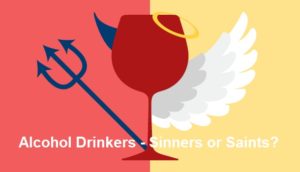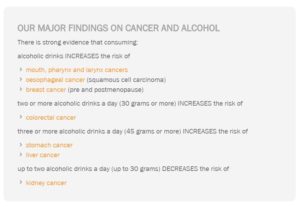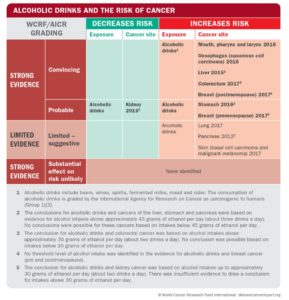
Most of us would find it hard to cut out alcohol completely, and usually we feel we can justify the occasional (or less occasional) tipple because we’ve believed the rumours that overall a small consumption of alcohol is actually good for us. However, the latest Expert Report by the globally-respected WCRF/AICR (World Cancer Research Fund/American Institute for Cancer Research) considers that any amount of alcohol increases our chances of getting any of five specific cancers, with a further three forms of cancer risk increasing if you have more than two or three alcoholic drinks a day.
Blog Contents
Which cancers are linked to alcohol consumption?
The WCRF/AICR’s 2018 Third Expert Report 1 evaluated the global causes of cancer and concluded that the risk of certain cancers increases with every drop of the hard (or red, white, frothy) stuff you consume. The following chart shows the five cancers that have been linked to even the smallest amount of alcohol consumption, along with a further three which have increased risk when you consume above a certain amount. Interestingly, there is one form of cancer that appears to have a reduced risk if consume alcohol – but only up to two drinks per day (that’s around 30 g of alcohol). Above that the jury is out.

What types and how much alcohol increases which cancer risk?
The following chart shows the weighted evidence for individual cancers with details of the quantity and type of alcohol linked to increased risk.

The Report specifically states that: “The evidence shows that alcoholic drinks of all types have a similar impact on cancer risk. This Recommendation therefore covers all types of alcoholic drinks, whether beers, wines, spirits (liquors) or any other drinks, as well as other alcohol sources. The important factor is the amount of alcohol (ethanol) consumed. Even small amounts of alcoholic drinks can increase the risk of several cancers. There is no threshold of alcohol consumption below which cancer risk does not increase, at least for some cancers.” 2
Which cancer would you prefer?
So, if it appears that you can decrease your chances of getting kidney cancer by having a couple of drinks a day, but only if you want to increase your chances of getting mouth, pharynx, larynx, oesophageal and breast cancers!
Increase your consumption above 2 drinks a day and you lose your safety net for avoidance of kidney cancer and introduce the risk of colorectal cancer.
Increase your consumption above 3 drinks a day, and you increase the risk of all the above along with good old stomach and liver cancer.
What about lung, pancreatic and skin cancers?
The Report doesn’t make clear conclusions about the precise risks of lung, pancreatic and skin cancers in relation to alcohol consumption; so does this mean we don’t have to worry about them as well when we down the next bottle of red wine?
Mmm, I’m not so sure about this. As we know, individual research projects do not always manage to get all the facts. If they did, then there wouldn’t be hundreds, and even thousands, of new studies on the same subject year in year out.
What the Report does say in relation to the above three cancers is: “There is also other evidence on alcoholic drinks that is limited (either in amount or by methodological flaws), but is suggestive of an increased risk of lung, pancreatic and skin cancers. Further research is required, and the Panel has not used this evidence to make recommendations.”
This, in my opinion, is good scientific practice – when there is insufficient clear research data to draw a conclusion, best not to draw one.
What are the mechanisms involved in getting cancer from alcohol?
There’s no definitive explanation, but the Report considers 3 that there’s a lot of evidence to suggest the following mechanisms:
- acetaldehyde, the principal and most toxic metabolite of alcohol, is the bad guy in this cancerous relationship. It appears that it can disrupt DNA synthesis and repair and may therefore add to a ‘carcinogenic cascade’
- higher ethanol consumption also induces oxidative stress through the increased production of reactive oxygen species, which are potentially genotoxic 4
- alcohol may also function as a solvent for cellular penetration of dietary or environmental (for example tobacco) carcinogens or interfere with DNA repair mechanisms
- those who consume a lot of alcohol might also have diets lacking in essential nutrients, such as folate, rendering target tissues more susceptible to carcinogenic effects of alcohol
There’s more information available 5 on the process by which cancer develops. You may also be interested in a blog I wrote about the fascinating subject, intimately related to cancer development, of angiogenesis and the work of Dr William Li 6 .
So how come you “get away” with kidney cancer risk?
As stated above, it’s interesting that the Report’s findings include a conclusion that kidney cancer might actually be prevented to some extent by consuming up to 2 alcoholic drinks a day. Why is this?
Well, it’s important to realise first that the Report states that: “The mechanisms that may explain the inverse relationship between moderate alcohol consumption and kidney cancer risk are uncertain…” They continue to say that the results are consistent with a variety of renal cancer subtypes 7 .
The potential biological mechanisms involved in the potentially positive relationship between moderate alcohol consumption and improved resistance to kidney cancer include:
- improved blood lipid profiles 8 among people who drink a moderate amount of alcohol
- higher adiponectin 9 levels
- the diuretic 10 effects of alcohol may be partly responsible for lowering the risk of kidney cancer among those who drink alcohol. However, to counter this, the Report states that: “…inconsistent results for the consumption of other fluids and of diuretics and kidney cancer risk do not support this hypothesis.”
My personal thoughts are that you would be “straining out a gnat and swallowing a camel“, as the “good book” says 11 , if you justify your one or two drinks a day (because of the potential increase in the avoidance of kidney cancer risk) while ignoring the other proven cancer risks associated with any alcohol consumption. But, we humans are a queer bunch!
More information on global cancer risks
If you want more useful information on global cancer risk, then it’s available from the WCRF/AICR Resources and toolkits page 12 .
The following is a short video 13 explaining the CUP (Continuous Update Project) methods and aims of the WCRF/AICR , if you are interested…
Coming up
In the next blog, we’ll have a quick look at what the 2018 Third Expert Report says about the risk of cancer in relation to the food we eat. I bet you can’t wait…
References
- Diet, Nutrition, Physical Activity and Cancer: a Global Perspective. The Third Expert Report). WCRF/AICR 2018. [↩]
- WCRF/AICR: Limit alcohol consumption. For cancer prevention, it’s best not to drink alcohol. Recommendations 2018. [↩]
- Mechanisms. Alcohol and cancer. Alcoholic drinks
Alcoholic drinks and the risk of cancer. WCRF/AICR 2018. [↩] - Wikipedia definition of genotoxicity. [↩]
- The cancer process. What is cancer and how does it develop? WCRF/AICR. [↩]
- Blood Vessels on the Menu [↩]
- Clinical Trials for Specific Renal Cancer Subtypes—The Time Will Come! Niels J. Ruppa, Rodolfo Montironib, Axel Mischoc, Holger Mocha. https://doi.org/10.1016/j.eursup.2017.08.007 [↩]
- Wikipedia definition of blood lipid profiles. [↩]
- Wikipedia definition of adiponectin. [↩]
- Wikipedia definition of diuresis. [↩]
- Matthew 23:23 [↩]
- WCRF/AICR Resources and toolkits page. [↩]
- About Continuous Update Project (CUP) 2018. YouTube video [↩]